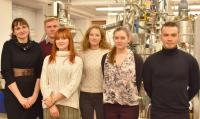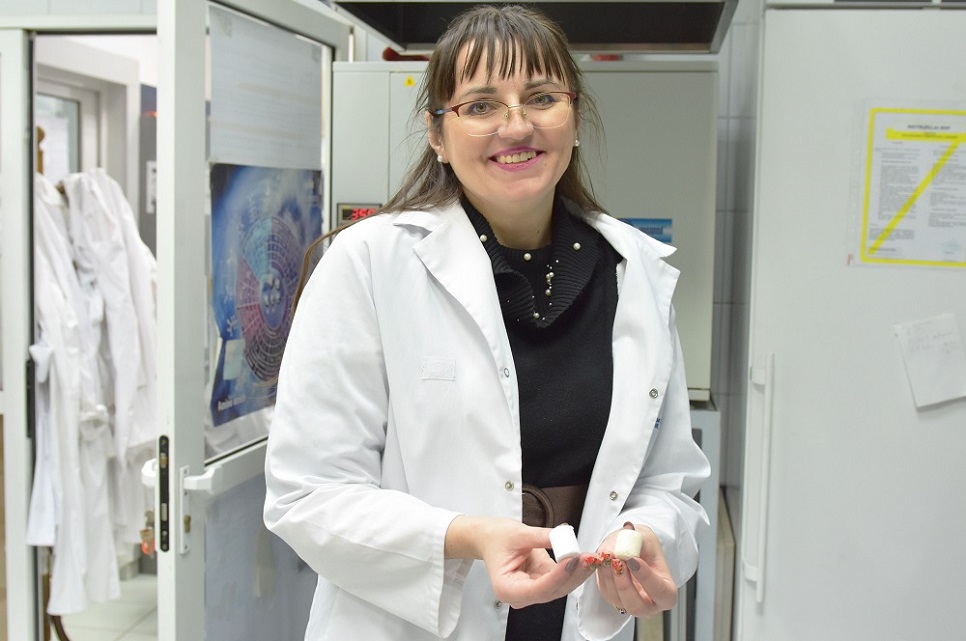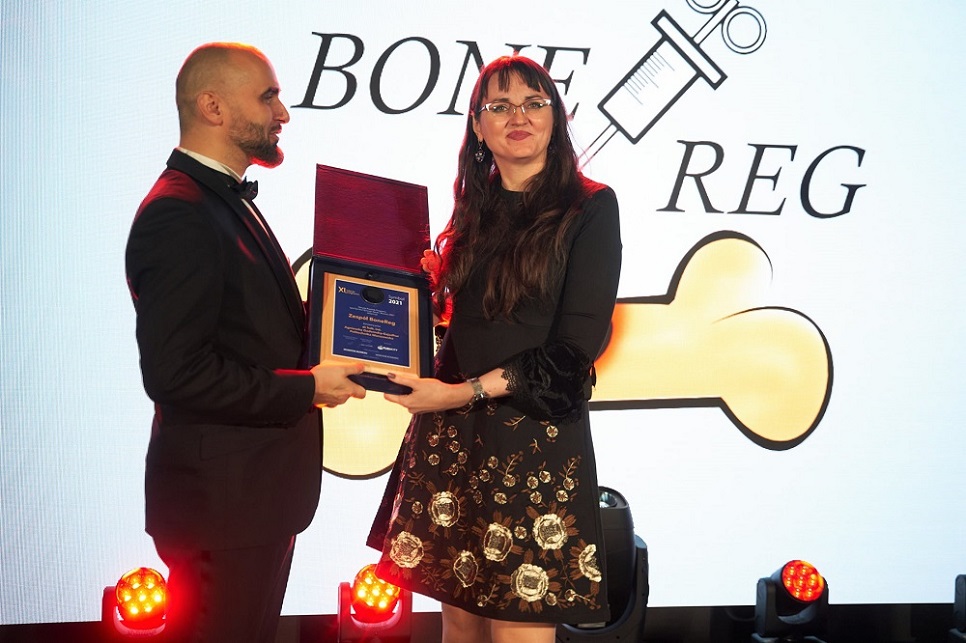Implants developed by our researchers will accelerate bone regeneration

Research team of the BoneReg project (from the left): Agnieszka Gadomska-Gajadhur, DSc PhD Eng., Paweł Ruśkowski, DSc Eng., Aleksandra Bandzerewicz, BSc, Joanna Howis, Anna Kołakowska, MSc, Krzysztof Kolankowski, MSc
The development of two cancellous bone implants that will accelerate the treatment of patients, among others, with osteoporosis - is the goal of the BoneReg project. It is being carried out by a team of researchers from the Faculty of Chemistry at WUT, and can already boast of successes.
– Every orthopedic surgeon inserting an implant endeavours to make the procedure as short as possible, the least invasive, and would like to use tools and procedures that they already know very well. We were also guided by such assumptions – explains Agnieszka Gadomska-Gajadhur, DSc PhD Eng., from the Faculty of Chemistry, Warsaw University of Technology, head of the BoneReg project.
The subject of the project itself, i.e. the regeneration of the cancellous bone, was commissioned by doctors. It was suggested by an orthopedic surgeon Prof. Krzysztof Ficek, with whom WUT researchers collaborate. Currently, the defects of the cancellous bone are replaced by two methods, which do not always yield good results leading to tissue regeneration.
The first of them - the transplant of a tissue "mosaic" taken from the deceased – carries the risk of transmitting the disease the donor suffered from. The material may also not be of good quality, e.g. when collected from an elderly person whose bones were no longer in good condition.
The second method is to administer a preparation consisting mainly of hydroxyapatite. It is a mineral that is an inorganic component of teeth and bones, which is the scaffold responsible for their strength. It is administered in places where the tissue is weakened or atrophies. However, as indicated by doctors, this solution does not always work.
Bomb implant
Researchers from the Warsaw University of Technology came up with two inventions that meet the needs of the medical industry. The first, on which work began a few years ago, was designed for a specific procedure – the reconstruction of the cruciate ligament in the knee. During the procedure, bone channels are drilled, that is, the bone is damaged in such a way that there is something the new ligament introduced into the body can be attached to.
Bone canals would be filled with an implant created by a team from the Department of Polymer Chemistry and Technology. It resembles a sponge and is very light, which is the result of its porosity – the material has a lot of hollow, interconnected channels that serve as a "scaffold" for cells in the bone that is being rebuilt. Due to the fact that the material is flexible, growth factors can be deposited on it, which help in the natural reconstruction of the bone. Platelet-rich plasma is such a factor, plasma collected from the patient to whom the implant is inserted, which ensures complete tissue compatibility.
– We chose to make an implant based on a biodegradable polymer that would gradually disappear in the body – says Agnieszka Gadomska-Gajadhur, DSc PhD Eng. – Furthermore, by providing a "bomb" of pro-regenerative factors, the bone would be able to rebuild itself naturally – adds.
Thanks to its flexibility, the implant can be freely trimmed by the surgeon in the operating room, which differs from those printed by 3D printing, which are very stiff and slippery. They cannot be fitted or stretched. Printing such an implant also takes a very long time and, therefore, it is not possible to adjust its size during the procedure.
Bone (for)mixing
In the meantime, studies have appeared showing that a much greater problem faced by orthopedic surgeons is the treatment of cavities caused by osteoporosis. The disease affects more and more women at a young age. It is estimated that 2.7 million Polish women suffer from it.
– We came up with the idea of a second implant, a bit similar to the commercial hydroxyapatite filling. It fills places where the bone is of reduced density. However, our implant will be two-component, and mixing will take place inside the bone. This is an innovative solution – says Agnieszka Gadomska-Gajadhur, DSc PhD Eng.
The procedure will not be invasive as there is no need to open the bone. Both components, containing stem cells taken from the patient, will be administered with a fine needle, most often through the articular surface. Inside the bone, where there is a low-density space or no cells at all, mixing will occur and a filling will form.
Thanks to the reinforcement, the bone will not break in this place. In addition, the delivered stem cells will cause a very quick natural bone reconstruction. What is more, after several months, when the stem cells are properly differentiated, constituting the patient's proper bone cells, the filling will decompose and will be removed from the body. Several candidates for both components of the implant have already been selected.
– At the moment, we are refining both implants so that they are as non-toxic to cells as possible and perform their functions in the best possible way after implantation – explains Agnieszka Gadomska-Gajadhur,DSc PhD Eng. – We plan to start animal tests in July next year – she announces.
The research will be assisted by ... a black sheep
As a model, the researchers chose a heath sheep – unusual for this species, because it is black. It was all about choosing an animal that grows quite slowly, just like a human.
– Heath sheep weighs between 50 and 60 kg – which is rather similar to the weight of a woman. The pressure that her body exerts on the joints, especially the front limbs, to which we want to insert the implant, is directly proportional to that of a human. For half a year, the animal gains several kilograms, so I think that this model will best show how the implant will behave in the body – explains Agnieszka Gadomska-Gajadhur, DSc PhD Eng.
If the results are positive, the team hopes to carry out clinical trials with humans.
Not only medicine
Researchers are also thinking about the use of implants in veterinary medicine, because various types of mechanical injuries to bones are quite common in animals. - They are typical of horses, which run very quickly or jump over obstacles. Most often, they are unable to return to form, which is why a ligament healing system is needed – says Agnieszka Gadomska-Gajadhur, DSc PhD Eng. – But this problem also occurs in very large dogs, especially in old age – she adds.
Vets from various centers that the researchers contact see the potential in the solutions developed.
Drop drills Rock
The team's achievements are already appreciated by the scientific and business community. In recent weeks, researchers have received significant awards. Both inventions were awarded with medals at the International Warsaw Invention Show IWIS 2021: a bioactive substitute for cancellous bone for the regeneration of the cruciate ligament – silver, and a two-component bone implant for the treatment of osteoporosis – gold. The team was also a laureate of the "Symbol for Science and Business Synergy 2021".
– It was a surprise for us, because as a small team, consisting of but a few people, we were among the distinguished laureates – companies employing hundreds or thousands of employees – says Agnieszka Gadomska-Gajadhur, DSc PhD Eng. – It also proves that it is worth working and not giving up. Drop drills Rock. We applied for funding several times and we succeeded in the "Lider XI" program of the National Center for Research and Development. I do not hide that this is only part of the research that we would like to carry out, but we are already thinking about further projects – she announces.
Importantly, the price of implants will be lower than the cost of currently used solutions. With the amount of PLN 600-800, in the case of using a tissue "mosaic", the cost of a bioactive substitute for cancellous bone should be approx. PLN 200. The two-component solution is also to be cheaper than the hydroxyapatite preparation.
Several companies, both Polish and foreign, are interested in the implants of the team from the Warsaw University of Technology. The talks are in progress.
The BoneReg project, ie "Porous, biodegradable implants for the regeneration of cancellous bone", financed under the "Leader XI" program of the National Center for Research and Development, is attended by: Agnieszka Gadomska-Gajadhur, DSc PhD Eng. – project manager, Paweł Ruśkowski, DSc Eng., Anna Kołakowska, Krzysztof Kolankowski, MSc., Aleksandra Bandzerewicz, BSc., Joanna Howis, as well as a large group of students.
Information about the project and work progress can be found on the BoneReg Facebook profile.











